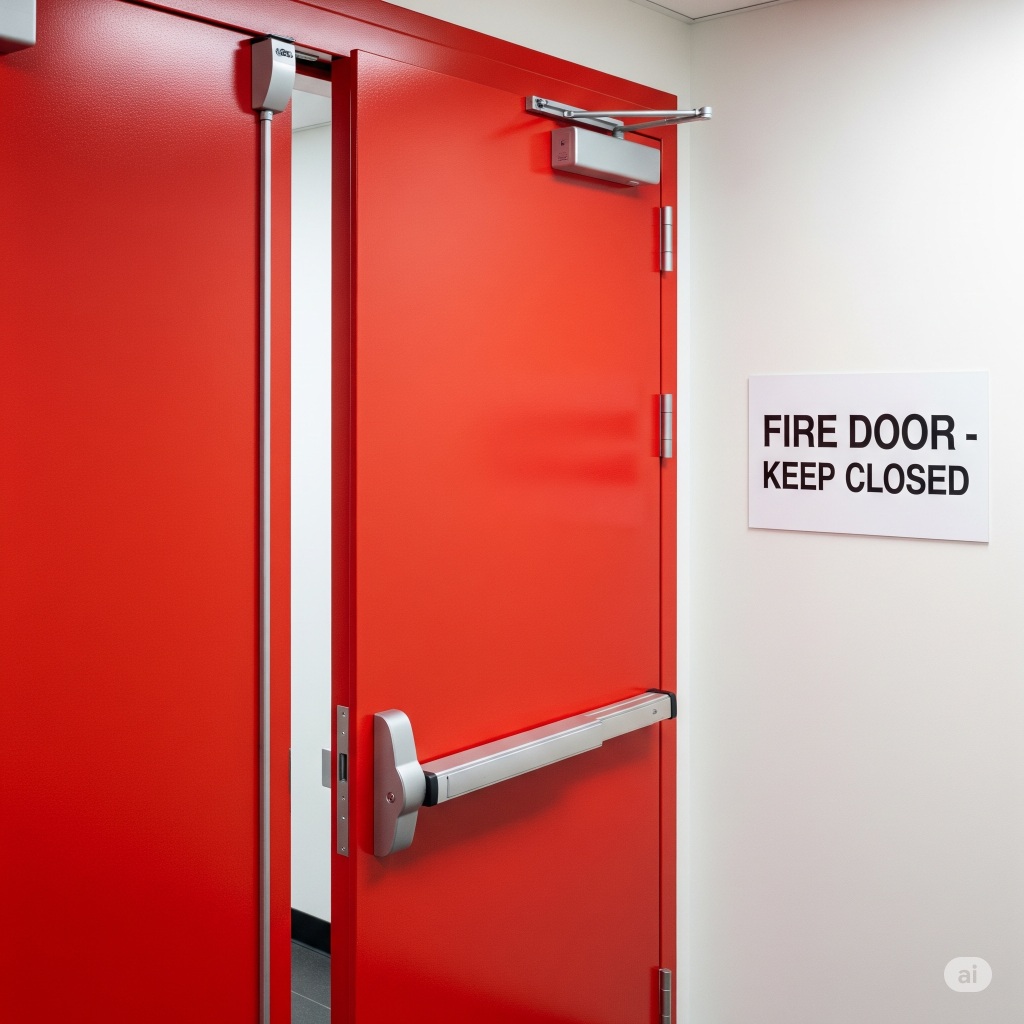
Fire doors are critical elements in building safety and fire prevention. Designed to withstand high temperatures and limit the spread of smoke and flames, fire doors serve as protective barriers that enhance the safety of occupants and property in the event of a fire. This comprehensive guide explores the function, types, standards, installation, maintenance, and overall importance of fire doors.
What Are Fire Doors?
Fire doors are specially designed doors equipped with fire-resistant materials and hardware intended to compartmentalize sections of a building in case of a fire. Their primary purpose is to slow the spread of fire and smoke, allowing occupants more time to evacuate and emergency services more time to respond.Key
Features of a Fire Door:
Signage: They are typically marked with a sign that says “Fire Door – Keep Closed” or “Fire Door – Keep Shut” to remind occupants not to prop them open.
Fire-Resistant Core: The door itself is made from fire-resistant materials like solid-core timber, gypsum, steel, or a composite of materials that can withstand high temperatures for a specific period.
Intumescent Seals: These strips are fitted around the edges of the door frame. When exposed to heat, they expand dramatically to seal the gap between the door and the frame, blocking the passage of smoke and flames.
Automatic Closer: This is a hydraulic or mechanical arm at the top of the door that ensures it automatically closes and latches shut after being opened. This is vital because a fire door only works when it is closed.
Fire Rating: Fire doors are rated for the amount of time they can resist fire (e.g., 30, 60, 90, or 120 minutes). The required rating depends on the building’s type and location within the building.
Types of Fire Doors
Fire doors come in various types, each designed for specific applications and environments:
1. Solid-Core Fire Doors
These doors are constructed with solid cores, often made of wood, steel, or composite materials. They offer a high level of fire resistance and are commonly used in commercial and industrial settings.
2. Hollow-Core Fire Doors
Hollow-core fire doors are lightweight and may feature an internal honeycomb structure for added strength. While they offer less fire resistance than solid-core doors, they are often used in residential settings.
3. Glass Fire Doors
These doors incorporate fire-rated glass that can withstand high heat while allowing visibility. They are often used in areas where natural light is desired, such as atriums or glass corridors.
4. Fire-Rated Rolling Doors
Typically used in loading docks and warehouses, these doors roll up to open and provide fire protection in large openings.
Fire Door Standards and Regulations
Fire doors must comply with specific regulations and standards to ensure their effectiveness. Key standards in the United States include:
- NFPA 80: This standard from the National Fire Protection Association outlines the requirements for fire door assemblies, including installation and maintenance.
- UL 10C: Underwriters Laboratories certify fire doors based on their ability to withstand fire exposure and ensure safety.
- International Building Code (IBC): The IBC specifies the requirements for fire door ratings and their application in various occupancy types.
Installation of Fire Doors
Proper installation is crucial for fire doors to function effectively. Here are the key considerations for installing fire doors:
1. Location
Fire doors should be installed in specific areas such as:
- Between different compartments or fire zones.
- At exits and stairwells to ensure safe egress during a fire.
2. Airtight Seals
Ensure that the door is fitted with proper seals to minimize air gaps. This prevents the passage of smoke and heat through the door.
3. Hardware Compatibility
Use fire-rated hardware (handles, hinges, locks) that meets applicable fire safety standards, as poorly fitted hardware can compromise the door’s effectiveness.
4. Installation Guidelines
Follow manufacturer instructions and local building codes during installation. It’s advisable to have fire doors installed by certified professionals to ensure compliance with safety regulations.
Maintenance of Fire Doors
Regular maintenance is essential to ensure that fire doors continue to operate effectively. Consider the following practices:
1. Monthly Inspections
Conduct monthly inspections to check for:
- Damage to the door itself.
- Proper functionality of the self-closing mechanism.
- Integrity of seals and gaskets.
2. Repairs
Address any damage immediately, whether it involves the door, frame, or hardware. Even minor dents or damages can affect performance.
3. Keep Clear of Obstacles
Ensure that fire doors are not blocked or propped open, as this can hinder their operation during an emergency.
4. Professional Maintenance
Consider scheduling annual professional inspections to ensure compliance with safety standards and regulations.
Importance of Fire Doors
Fire doors play a vital role in fire safety strategy for any building. Here are some key reasons why they are indispensable:
1. Life Safety
Fire doors provide crucial time for occupants to escape during a fire by slowing the spread of flames and smoke, thus enhancing overall safety.
2. Property Protection
They also help mitigate damage to property, potentially saving thousands of dollars in repair costs by containing fires to specific areas.
3. Compliance with Regulations
Fire doors are often required by law and building codes, making their installation and maintenance essential for legal compliance.
4. Insurance Benefits
Proper installation and maintenance of fire doors can positively impact insurance premiums, as they demonstrate a commitment to safety and risk reduction.
Conclusion
Fire doors are essential in any fire safety strategy, serving as a critical barrier against flames and smoke. Understanding their types, standards, installation, and maintenance can significantly enhance building safety. Investing in proper fire door systems not only meets regulatory requirements but also ensures the protection of lives and property. By prioritizing fire safety and educating occupants about the importance of fire doors, communities can work towards a safer environment for all.
